Shift Left Testing Tutorial: Comprehensive Guide With Best Practices
This guide explores the shift left approach to testing and how you can use it to improve your software product's quality.
Join the DZone community and get the full member experience.
Join For FreeA shift left testing approach involves moving testing activities "left" or relatively "early" in the development cycle. Thus, testers are involved earlier in the software development life cycle, enabling them to identify bugs and bottlenecks at an earlier stage. In addition to improving the quality of the code and reducing the time it takes to complete the cycle, it helps ensure fewer defects are introduced to production.
Organizations are constantly challenged to move faster in an agile environment. Typically, this entails shortening the delivery time while improving quality with each successive release at reduced costs.
Agile development initiatives have prioritized short sprints and planned to incorporate customer feedback into features as promptly as possible. However, such advancements encounter severe quality issues unpleasing to customers. Following this, the drift in testing and quality has emerged, where "moving fast and break-in things" is no longer sustainable, and testing has become a significant stumbling block.
In traditional models, testers usually start testing after development. In response to this, a quality assurance technique known as shift left testing has emerged. It offers advantages such as cost savings and bug detection upfront.
What Is Shift Left Testing?
The shift left approach urges us to rethink how to approach software quality improvement. Earlier, in a waterfall methodology, developers and quality assurance experts worked in a team with distinct roles and responsibilities. Even in agile methods, testing usually comes last.
The idea of shift left testing intends to bring the testing stage much earlier in the software development life cycle (SDLC). Therefore, teams can work together more effectively and collaboratively and communicate regularly with one another. Thus shifting left is a common term for early bringing together testing and development.
Let's consider a scenario where everything is completed on the developers' side. They hand over to the testing team, to begin with system testing, and the development team starts on new projects. During QA testing, tests come up with bugs that must be fixed before they can be released to production. In this case, the developers again stand by the current task and concentrate on fixing bugs in the last project to mitigate deadlines, or the deployment would have to wait until a new release cycle. Talk about this extra investment of time!
The shift left approach aims to improve quality by moving tasks to the left as early as the life cycle. It incorporates testing earlier in the software development life cycle by repeatedly testing and detecting issues and minimizing the risks early. Therefore, a shift left in testing might be a more realistic way of detecting bugs for products compared to typical testing approaches, which start testing at the end of development.
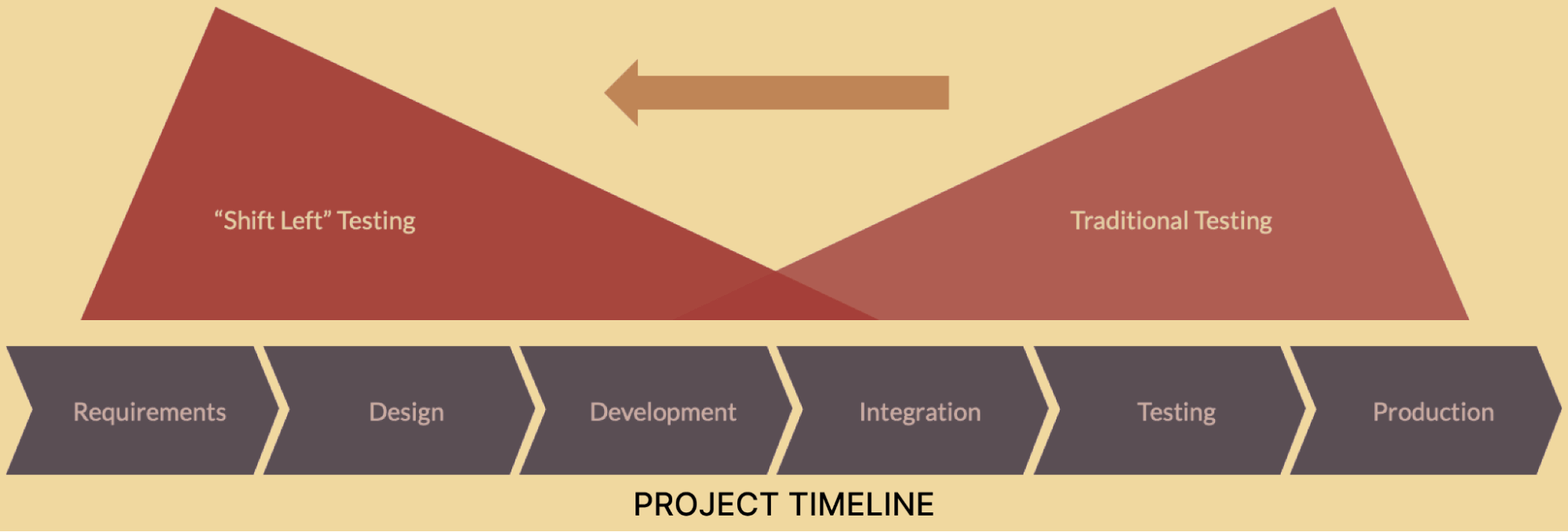
Impact of Testing Late in the SDLC
Defects are more complex and expensive to fix that are found later in the life cycle. This is why treating testing as a sequential phase at the end of the waterfall approach has been regarded as a major pitfall of software testing.
Following are the impacts of testing late in the development cycle.
- Testers may be less engaged in initial planning, resulting in inadequate testing resources being allocated.
- Many requirements, architecture, and design flaws are not discovered and rectified until a considerable effort has been spent on their implementation.
- As more software is created and integrated, debugging becomes more difficult.
- Less time for test automation, which eventually leads to regression defects.
- Encapsulation makes white box testing and achieving high levels of code coverage during testing more difficult.
- There is less time to fix defects discovered during testing, increasing the likelihood of being postponed in the later system upgrades.
- Late testing impacts development and maintenance costs, leads to missed deadlines and project delays, and lowers quality due to residual defects.
- Customers get a bad end-user experience due to buggy software.
Why Shift Left Testing?
With a traditional waterfall model, where testing occurs at the end of the cycle, severe defects are often missed. Such critical bugs are difficult and costly to fix at the end of the process. As bugs are discovered, the cost of fixing them rises exponentially.
However, shifting left testing by involving testers early in the cycle helps to reduce costs associated with bug discovery and fixes. As a result, there is no delay or impact on the deliverables of the project, and it improves customer satisfaction.
Here are some appealing factors why we see a rapid drift towards the shift left approach.
- By joining coding and testing, the shift-left methodology lessens code insecurities. Also, this builds engineers' productivity.
- The shift left methodology empowers engineers to rapidly test code through ceaseless coordination (CI) and test automation. This permits groups to develop their SDLC toward constant testing and the CI/CD pipeline.
- Discover bugs almost immediately in the product advancement life cycle.
- Cut down the expense of addressing bugs by recognizing them almost immediately.
- Discover bugs almost immediately in the product advancement life cycle.
- Shift-left testing in DevOps brings about a more significant item. This builds consumer loyalty and improves business results.
- Gain a more significant item as the code contains fewer fixes and code fixes.
- Have fewer possibilities that the item overshoots the assessed course of events.
- Give higher consumer loyalty as the code is steady and conveyed inside the financial plan.
- Keep up the greater codebase.
- By testing before the cycle, groups can discover costly deformities sooner. This sets aside time and cash.
- The shift left approach permits groups to design the whole testing extension even more likely for their ventures.
Benefits of Shift Left in Testing
Shift left does more than find bugs earlier. It helps the team collaborate better with all stakeholders, improve collective competency, and craft more realistic test cases to ensure defect-free delivery. Shift-left testing brings several cultural benefits since it emphasizes areas of the agile manifesto's well-known principles.
- Responding to change over following a plan.
- Customer collaboration over contract negotiation.
- Working software over comprehensive documentation.
- Interactions and individuals over processes and test tools.
The following are a few significant advantages of shifting left testing.
- Improved customer and user experience: Shift left promotes high-quality code and on-time delivery with lesser bug fixes, creating a more intensive customer requirements-focused environment that leads to better product design and user experience.
- Early bug detection: Early, progressive, continuous testing reduces the number of defects before they cause issues in production.
- Enhanced coverage: The additional advantage of shift left tests is increased test coverage. Tests will evaluate a more significant percentage of your software if more people create tests more frequently and start earlier.
- Significant cost savings: Early detection considerably results in increased efficiency and reduced technical debt, reducing project costs in terms of effort, time, and cost involved in bug fixes.
- Improved software team culture, competency, morale, and employee retention: Getting everyone on the delivery team involved in testing activities requires shifting to the left. Your team no longer discusses and performs testing as a last-minute rush just before release.
- Helps reshape product development: Shift left in testing doesn't mean that we are not testing in production or that testing is completely shifted to the design phase of the software development life cycle. Shift left injects testing into each sprint. Some testing should still occur at the end but should be residual.
What Happens When You Shift Left?
In the shift left approach, the testers learn first-hand about the ultimate standard for testing the release. For example, testers may realize that it's much more efficient to work closely with component and system developers as they learn about the product specifications. They can ask probing questions, meet with the API developers and work to create test stubs for new services. As testers are actively involved in these earlier phases, they are eventually "shifting left."
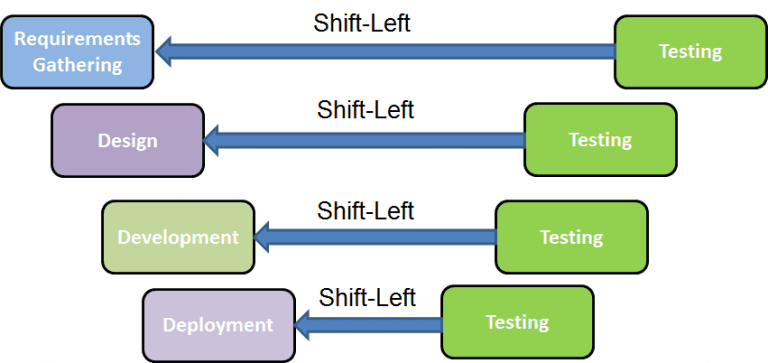
Let us look at what happens when you incorporate a shift left approach in testing.
Design Phase
Traditionally, the product design team would wait until they had a critical mass of new features and start a long process of designing them. Until then, testers might have been aloof from the fact that the new features were underway. In modern software development, we can test new feature ideas immediately by bringing in the questions below.
- What is the purpose of the feature? What problems does it solve for our customers?
- How will we know this feature is successfully meeting customer needs?
- What could be the smallest slice of the feature that can be built and used as a "learning release" to ensure it delivers value?
- What is the worst and best thing to happen when people use this feature?
Using Tests Continually to Guide Development
Here's a typical "shift left" scenario: Your team has decided to build a feature, and you're having a specification discussion in the planning session with the delivery team. Just asking, "How will we test this?" leads to a productive discussion because it helps you understand the feature and might lead to implementing tests for those stories at the unit, integration, system level/API, UI, or other levels as applicable.
Designing Test Plans
Rather than formal test plans, the team can capture a couple of instances of desired and undesired behavior for every story as they are created. We can turn those into tests. The team can run that and help with the development.
These tests become a detailed documentation of how the feature works once it is in production, and automated regression tests can ensure that no future changes will break it. One way to increase your team's chances of delivering precisely what your customers want is to think of more test cases to automate or manually explore as each feature is built.
Test Early and Often, Automate Early and Often
The perk of agile development is that we can automate as you go. You can write the most fundamental test for a capability even if we have yet to develop it fully. You can add incremental tests to the production and test codes for this capability. There needs to be more rework, more knowledge of how to write maintainable tests, and more waiting for questions to be answered when testers, developers, and other team members collaborate to automate tests as coding progresses—quite a deviation from waterfall processes' handoffs.
It's Not Just About Testers
The shift left approach is a technique in which the entire software team is involved. Here are some adaptations that each role needs to make to support this:
- Testers: Participate actively in the design phase. To test a build, you shouldn't wait for the code. Try to separate client stories into little testable pieces to guarantee that tests are successful and significant.
- Developers: Participate in discussions about test strategy and planning. Your input may help alleviate the testing team's burden and lower your technical debt. Maintain your automated test suites as an essential component of the code base.
- Product managers: Make sure your teams have access to the right resources to work together and receive feedback. Set objectives and expectations that are compatible with the shift left strategy. This might entail setting quality objectives for the entire team and anticipating less feature work per sprint.
- Infrastructure and deployment teams: Your deployment pipeline needs to be available early and have a high capacity so test suites can run promptly because testing needs to happen frequently and early.
Types of Shift Left Testing
There are four different types of shift left approaches, each providing different values.
- Traditional Approach
- Incremental Approach
- Agile/DevOps Approach
- Model-based Approach
1. Traditional Approach
To understand the traditional shift left approach, it's important to first understand the traditional V-Model in a software development life cycle.
The SDLC V-Model is an extension of the waterfall model based on the inclusion of a testing phase for each development stage. It is also known as the verification and validation model. The image below shows a typical V-Model.
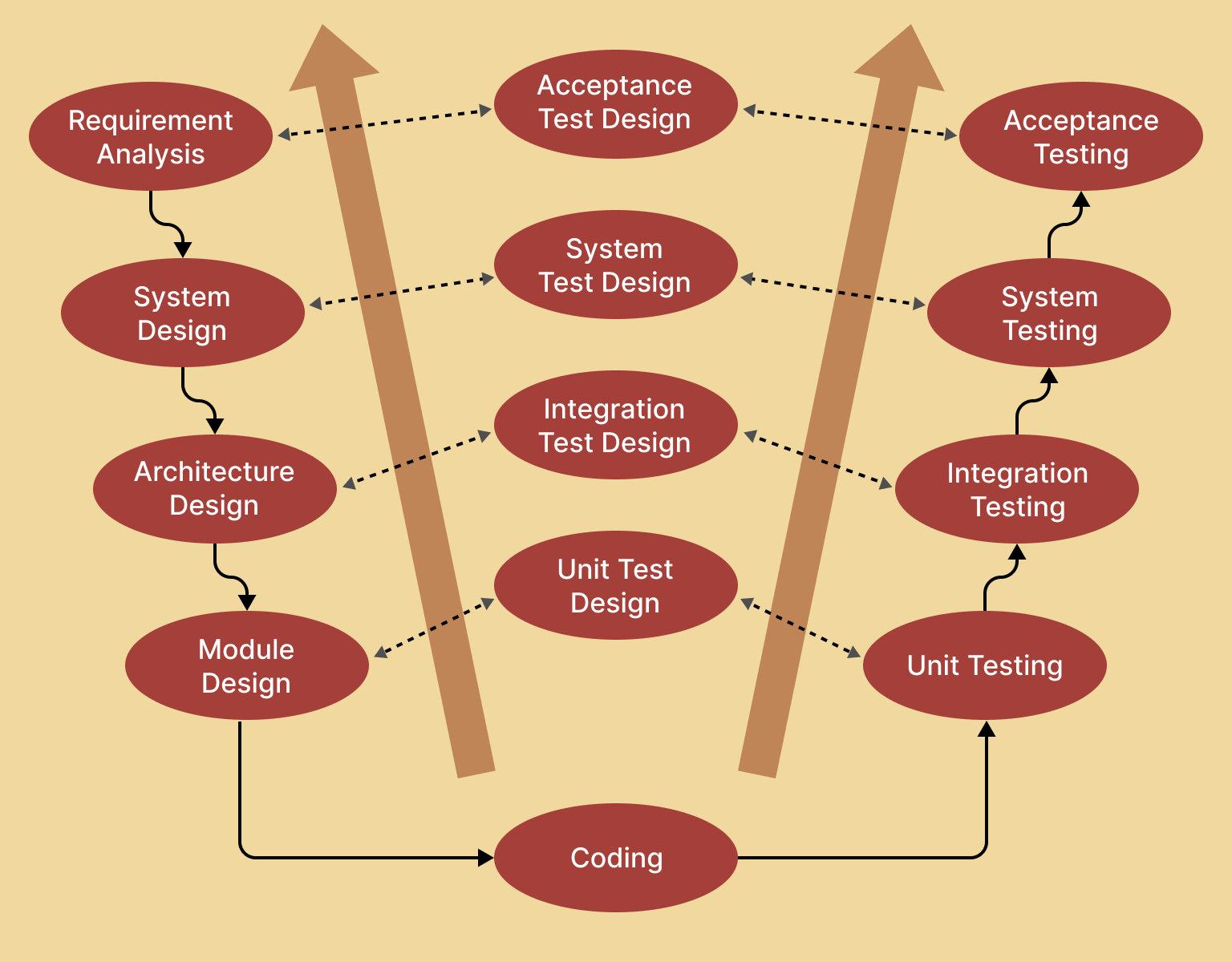
The traditional shift left approach lowers the testing and thus moves it to the left on the right side of the V-Model. Unit testing and integration testing are the primary focus in the traditional shift left approach. This type of testing is done using API testing and Selenium. However, acceptance testing and system testing are not emphasized heavily.
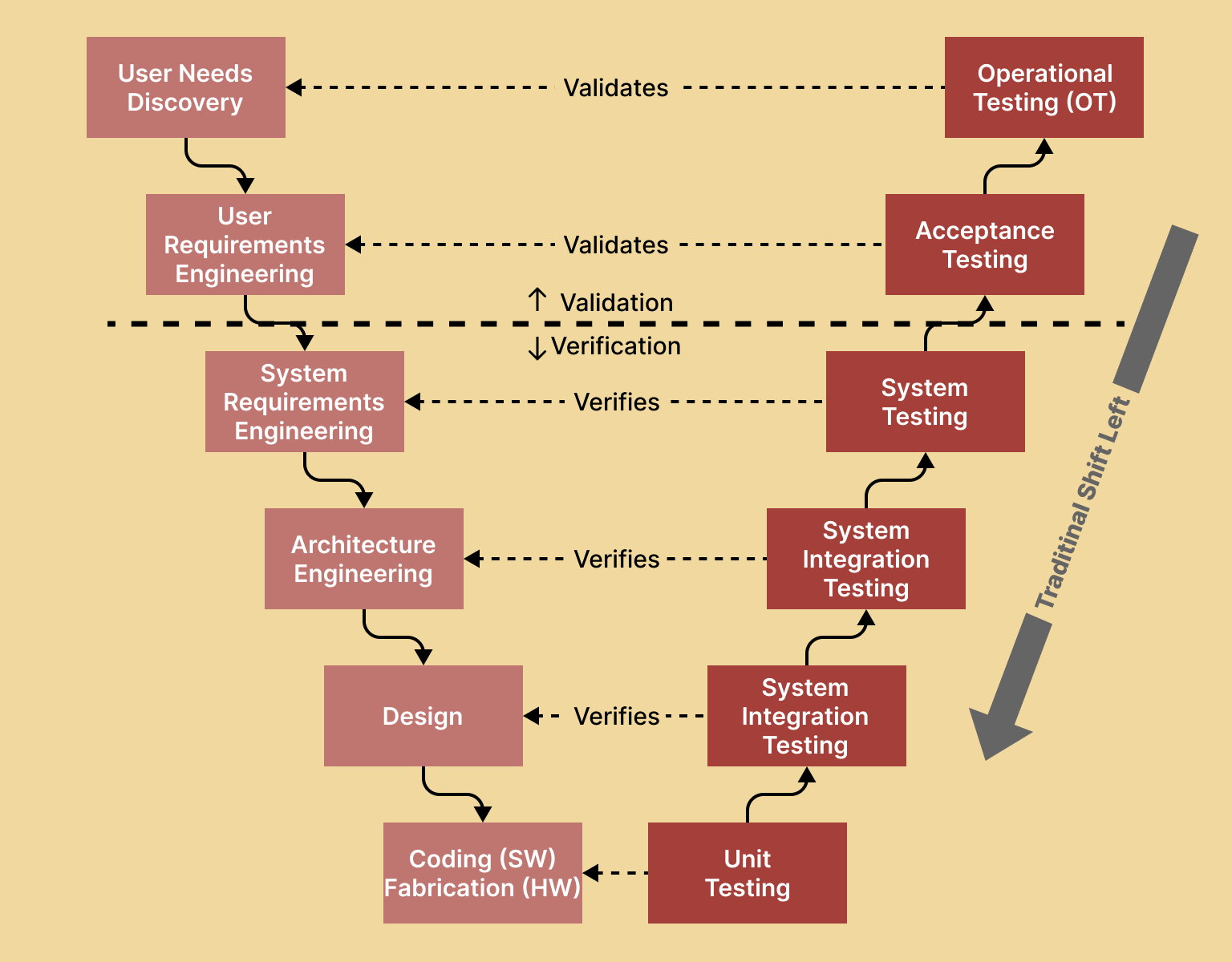
2. Incremental Approach
This shift left strategy best suits projects developing complex and large software systems. Sometimes, it becomes difficult to manage all the tasks and deliverables simultaneously. As a result, they are divided into smaller chunks. These components are built upon one another, and the software is delivered to the customer with each increment. Following each delivery, development, and testing are shifted to the left. This benefits the testing teams to test each component.
Thus, it involves incremental testing by having an incremental development cycle. The following image shows an example of this process.
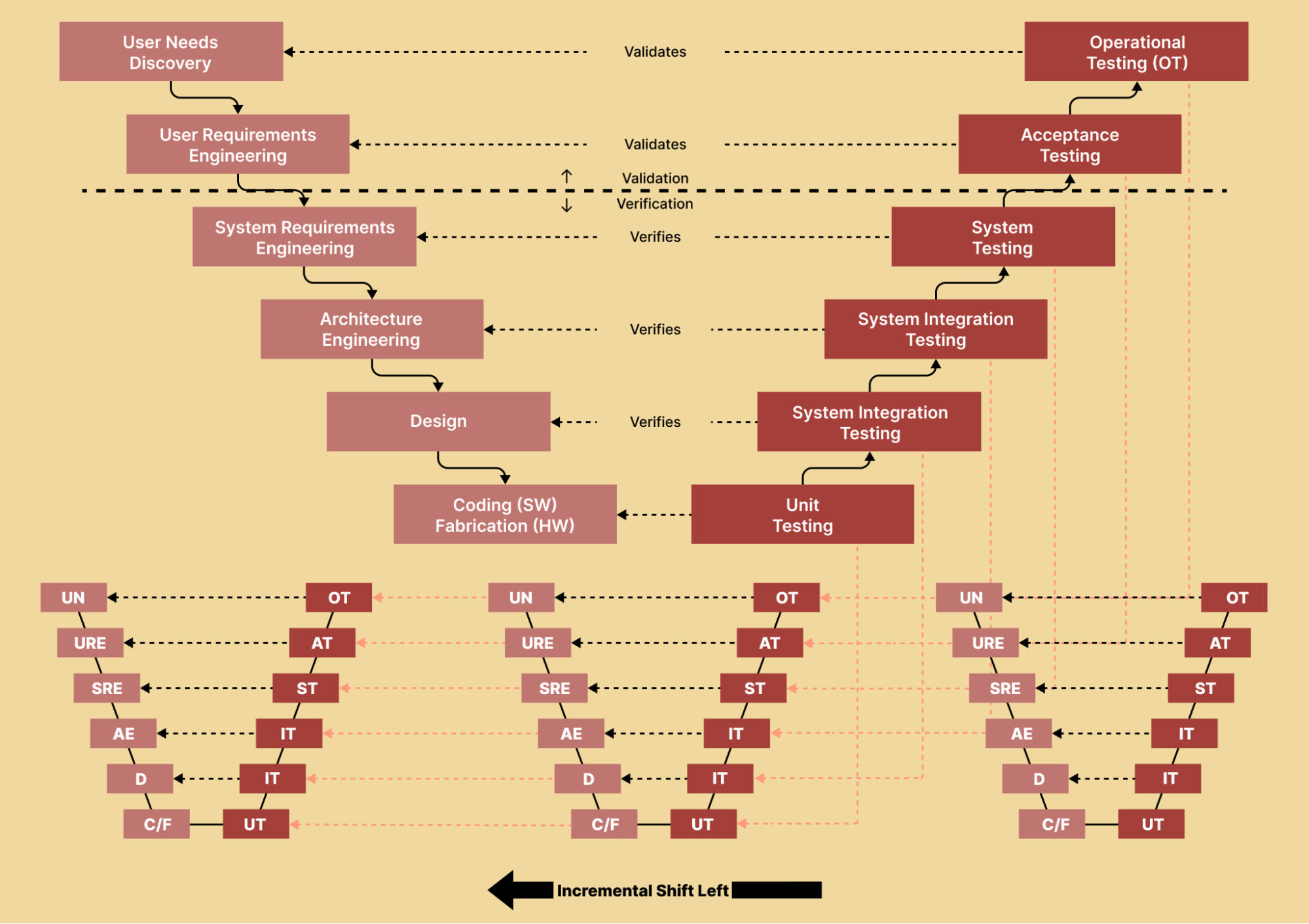
3. Agile/DevOps Approach
This shift left testing approach is typically carried out over several sprints. It focuses on continuous testing through an evolutionary life cycle of various smaller sprints. It is primarily used for developmental rather than operational testing, which occurs after the system has been operationalized.
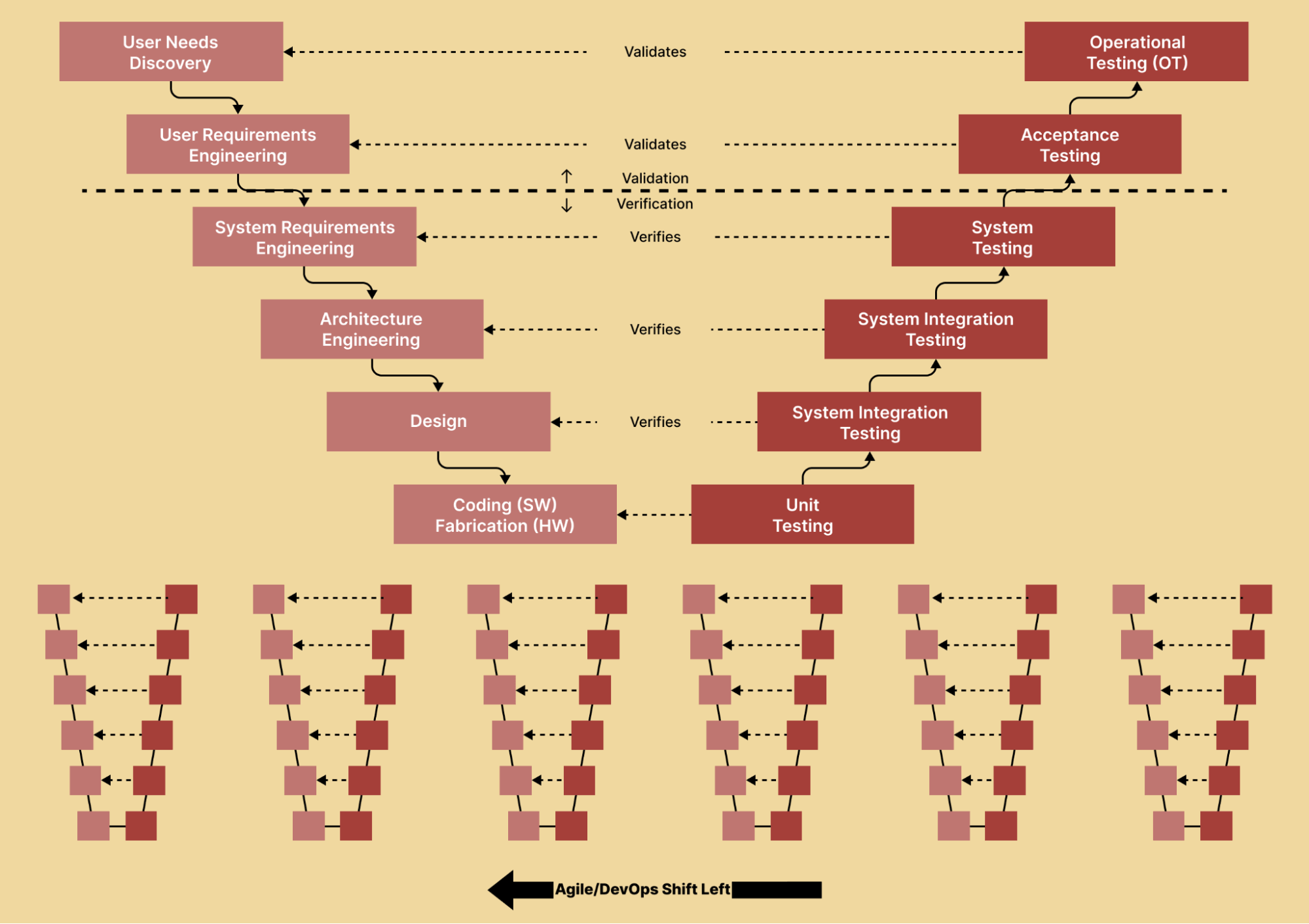
4. Model-Based Approach
The main objective of the shift left approach is to catch bugs early. However, in the three models discussed above, testing would begin earlier in the development cycle. As a result, some critical issues are missed during requirements gathering, which is later discovered once the development cycle is completed.
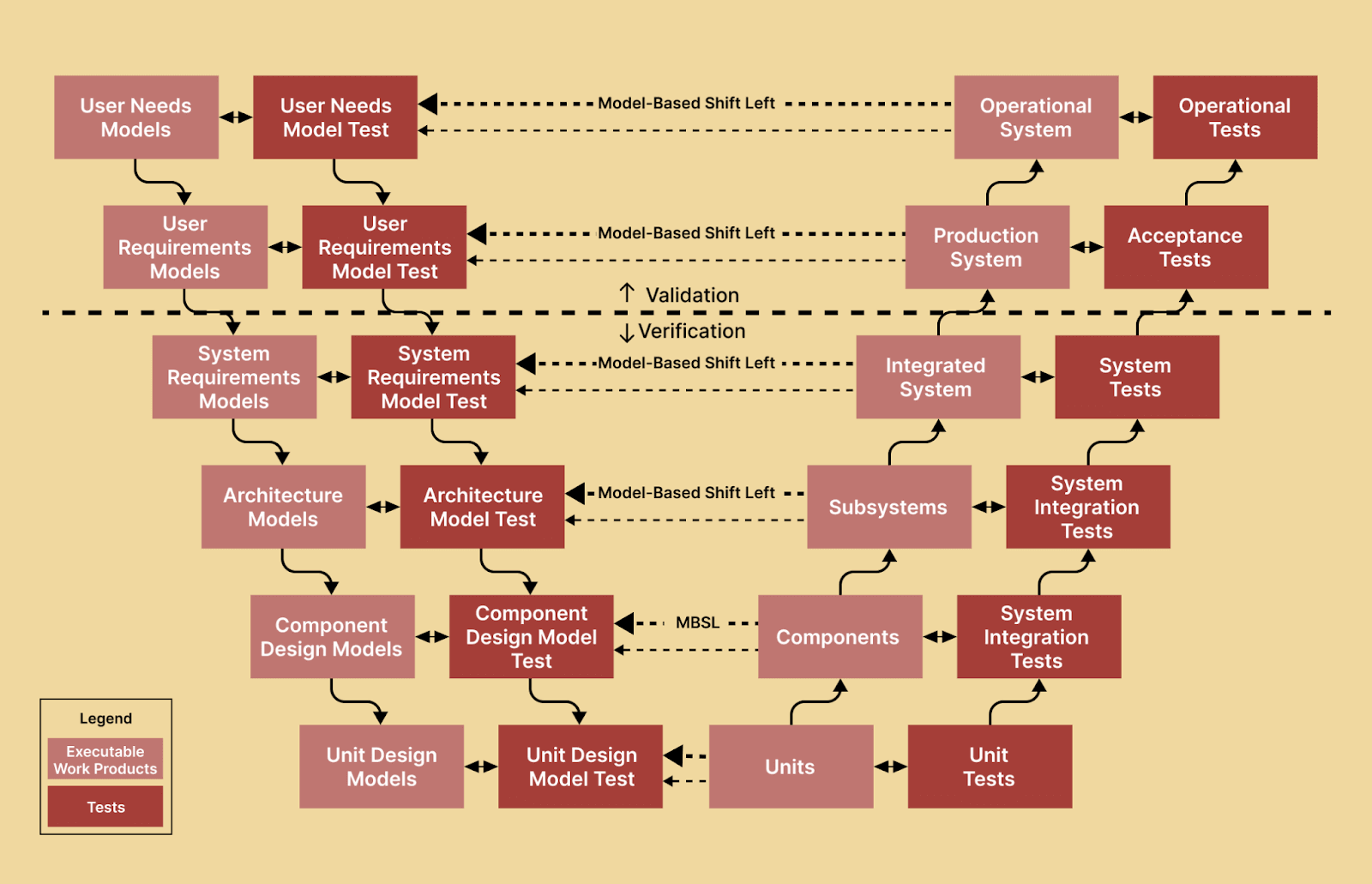
Key Strategies to Shift Left
Here are some key strategies you can implement to shift your software testing to the left.
- Planning: It is an essential aspect of the shift left strategy as it serves as a springboard for test life cycle tasks. Testers can better understand future demand by collaborating with management and operational stakeholders. With this insight, you can plan and confirm the budget, resource allocation, and testing strategies.
- Static testing: It is done in the early stages of a project and comprises requirements and design validation. Using static testing, you can uncover problems early in the project's life cycle before they become too costly to fix.
- Unified test strategy: With a unified test strategy, you can evaluate constraints on automation, stubs, environments, and test data, guaranteeing that the respective teams can meet the requirements. In general, this is a high-level approach for end-to-end testing, from unit tests to user acceptance tests (UAT) to operational readiness tests (ORT) and post-deployment tests (PDT). This strategy will cover all QA responsibilities and steps.
- Risk-based analysis: Software risk analysis determines every test case's consequences and probability of failure. Functional, non-functional, and regression testing can all be carried out using this method.
How To Implement the Shift Left Strategy?
Shift left does more than just help teams find defects early. Now let us find out what your teams need to do to get started with shift left tests.
Identify and Plan the Testing Life Cycle
Planning is integral to the shift left approach. It works best when the test analysts identify and plan the entire testing life cycle before the start of the actual development process. This provides a strong starting point for all activities in the test life cycle and will help all business and operational stakeholders, developers, and testers understand the project's tasks, objectives, and expected outcomes.
One way of doing this is by identifying testing requirements from the project planning and requirements specification phase. The test plan includes budget, resources, testing strategies, and other project requirements. This helps teams focus on quality from day one of the project rather than waiting for defects to be uncovered late in the software development life cycle.
Induce a Developer-Based Testing Approach
The primary role of a developer is to code new features or enhancements per the requirements. However, testing is no longer an activity done by a tester.
As the developers are most familiar with their codes, they can rigorously test their code to rule out any errors and check the application's functionality. It is also essential to ensure that the new code does not give rise to any defects when integrated with the application's existing functionality.
So, testing the code as soon as it is developed ensures quicker defect identification. It speeds up exposing and fixing coding errors. It helps in reducing uncertainty in a unit. Development testing aims to eliminate coding errors before the code is passed on to the QA team. A perfect blend of both developer-based and QA-based testing would ensure easy defect identification and quality feature release.
Code Review Quality Checks
Collaboration is the key to success. To ensure higher code quality, all developers must agree to conform to the same coding standards.
With the developers now contributing to the testing efforts, the testers can focus on defining quality checks for the developers' scripts and focus on exploratory, security, and performance testing.
Use the Same Tools
One of the significant issues faced by the testing team is the inability to create automated tests using the same tools used by the developers. This becomes a roadblock for testers creating the automation framework. A best practice is using the same technology stack the developers use.
Feature Testing
It is the process of making changes in software to add new features or to modify the already existing features. Testing these features is extremely important, and delivering software incrementally necessitates the development and QA teams to work collaboratively to deliver a build.
The actual state of the system in terms of bugs is known after every check-in. With stringent code quality checks, the defects are detected at an early stage and hence are easier to fix, resulting in improved quality of each feature.
Engage in Test Automation
In this DevOps-driven landscape, it is highly recommended to adopt test automation to maximize the avail benefit of shift left tests. With test automation, developers and testers can automate the entire build-to-test process across all the stages of software development.
To reduce testing costs, always use cloud-based testing platforms so your QA teams can access different browsers, devices, and platforms.
Challenges of Shift Left Testing
As we saw, the shift left strategy offers many benefits. However, everything has its challenges. Here's a limitation of shift left testing.
Acceptance
The first on the list is acceptance. Shift left testing demands a significant shift in the culture of the organization. Developers and testers accustomed to traditional work processes might find shifting left a deviator. It could disrupt the flow of work, tools, and required skills.
How To Overcome It?
It is essential to internalize the importance of shift left testing. Moreover, learning sessions advocating the priority help ensure a smooth transition to the new approach.
Residual Effort
Only some things can be tested early. Shift left testing could involve considerable investment in effort and time if the foundation still needs to be laid. In a situation where we write tests before the development of GUI, there are high chances that GUI characteristics could require more enhancements by the time it is developed fully, so most of your effort has been wasted.
How To Overcome It?
The development must be done earlier if a specific test needs to be tested early. For example, if API testing is vital for your project and you are trying to do shift left testing, develop the API early.
Coverage
Have we covered it all? How much automation is needed? Do we have full-proof delivery ready? Answers to these questions can be mind-tickling.
How To Overcome It?
Defining an intelligent test strategy holds the key to successful automation testing. Here is the list of factors that can help you determine whether you should automate a test case.
- Automation complexity
- Average script creation time
- The desired speed of regression
- Frequency of releases
- Stability of the build
- Rate of change/addition of test cases
Best Practices for Shift Left Testing
In this section, we discuss some of the best practices one should follow while implementing the shift left approach.
Providing Continuous Feedback
Continuous feedback allows misalignments and gaps to be fixed rapidly. Also, it gives a better insight to everyone involved and improves them for future projects.
To achieve an effective continuous feedback loop, organizations should:
- Set goals for the meeting.
- Take detailed notes of the feedback.
- Ensure an effective communication pipeline.
Early Testing
Testing early should not imply that testing does not occur in later SDLC stages. Testing early inherently allows early risk mitigation by early defects detection. This does not mean defects cannot emerge in later stages. Therefore, QA specialists and project managers should be prepared and utilize continuous testing.
QAs should lay out the degree of value, execution, and operational achievement anticipated from the code so that developers running tests understand what bugs to search for.
Automation Testing
Each update, release, customization, and integration poses a new threat to the overall quality of the system. In addition, manual testing doesn't meet the demand for faster, higher-quality software development.
A viable approach is to use test automation that saves a considerable amount of time for testers.
Static Code Analysis
Static code analysis is analyzing the code without execution. It goes through the fundamental code structure and guarantees that the code is lined up with various norms and rules. In this analysis, the code is checked against the guidelines and standards. Another perk of static code analysis is that we can automate it. But we should do such an analysis early in the SDLC.
Conclusion
Getting involved with testing at all points in the continuous development cycle can be daunting. Still, many success stories from the testing community show that it's possible no matter your role.
Some experts say the best way to show developers how to test is to be a developer who has tested. Others say a 'stop and think and test/ review' at every stage in our projects. If you have some coding experience or are interested in learning, combining your testing expertise with hands-on development work is a great option.
Inarguable that each testing member is cordially responsible for creating high-quality delivery. If your project or organization is trying to shift to the left, the above pointers could be a good handbook for you to be in a position to deliver an excellent product at a faster rate.
Published at DZone with permission of Rhea Dube. See the original article here.
Opinions expressed by DZone contributors are their own.

Comments